Introduction
So often in war the footwear worn by soldiers is often the rarest to survive. In World War Two and the Vietnam War boots were an essential portion of military kit for each soldier. Many brave soldiers died wearing their boots. The harsh conditions of battle meant that boots wore out quickly and were often in need of repair. For that reason, war time manufacturing of boots tripled in the mid-twentieth century compared to any other point in United States History. The FA&M collection features a pair of men’s WWII boots, men’s Vietnam Boots, and women’s nurse’s boots from WWII. But the United States was not the only century to issue boots to its soldiers, in WWII Japan issued a unique form of footwear called the Jika-Tabi. The FA&M has a pair of Jika-Tabi in its collection. Exploring the history of these four pairs of boots offers a tangible connection to the soldiers of the twentieth century.
WWII European Boots
When we think about the uniforms of WWII the footwear worn by the armed forces is often overlooked. But for the soldiers fighting in the European theater the boots they wore were a critical piece of kit. So, few examples of these boots have survived, many were destroyed by mud and rot. The FA&M is fortunate to have two well preserved examples of WWII combat boots in its collection. One being a men’s boot —made from brown leather and a rubber sole (model 2)— from the European theater Dr. B. Bohleke provided an example of the model 1 men’s boots—made from the same materials— for comparison with the model 2 boots in the FA&M collection. The model 2 boots had a high cuff that goes above the ankle and the model 1 boot does not have the ancle buckle. The model 1 boots were donated and worn by Dr. Benjamin Nispel (1st Lt) between 1943-1945. The boots were made by the Avon Du’Flex Sole Co.
The second pair of WWII boots are a woman’s nurses’ boots —made of kaki colored leather and a rubber sole— from both the North African and European theaters. In WWII there were more than 350,000 women who enlisted in the Armed forces. One of the areas enlistees entered was the Army Nurse Corps originally founded in 1901. It is interesting to note that there were only 56 African American Nurses in the corps in 1941. Mrs. Esther Nelson née Mellotte entered the Army Nurse Corps on May 10, 1941. She tended to the wounded in both the North African theater and the European theater from 1941-1946 in the 23rd station hospital. She earned the European African Middle Eastern Theater Campaign Ribbon and the American Defense Service Medal.
Read Esther Nelson née Mellotte’s letters about her experiences in WWII. Courtesy of the Fulton County Historical Society, Inc.
Discussion Questions
List some of the major battles of the European Theater and think about where these men’s boots could have trod?
Think about how nurses were a vital part of the war effort. What were their responsibilities? What did Mrs. Nelson’s boots witness?
Model 1 Boots:
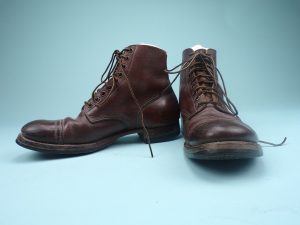
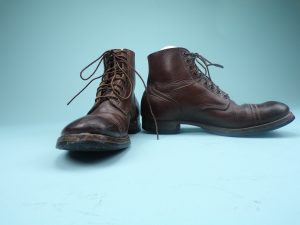

Model 2 Boots:
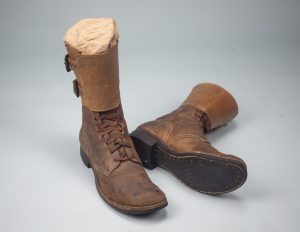
Photographic examples:
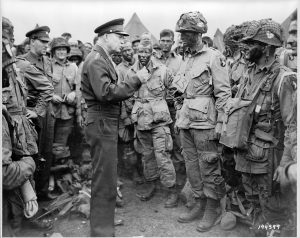
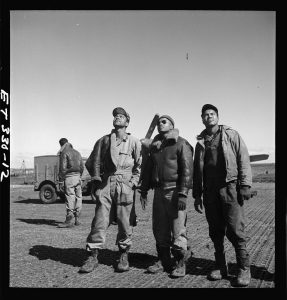
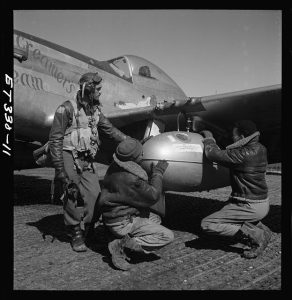
Imperial Japanese WWII Boots
A usually forgotten but incredibly important part to any soldier’s equipment is their boots. A quality set of boots allows infantrymen to be on the move daily with comfort to the wearer, whereas a poor pair of boots could slow down, or even significantly injure its user. These different military boots, worn in the Japanese, American, and Soviet armies, exemplify how these soldiers dressed for different conflicts, and how their different designs supported them through war. The Imperial Japanese Army had to dress for their varied terrains throughout their territories. As such, their boots needed to accommodate these different areas that soldiers needed to traverse through, requiring some different methods for better traction and comfort.
The Jika-Tabi, donated by Chauncey M. Depuy, was a style of shoe common in Japan, featuring a split-toe. The shoes themselves were used, albeit seldomly, by specific units of the Special Landing Naval Forces (land forces for the Japanese Navy). The split-toe was considered exceptional at giving the wearer better grip on the ground, and the soles had different tread patterns, necessary in Japan’s geography. Jika-Tabi were typically worn during down time, but were sometimes worn when out in the field. While the soles helped with traction, their distinct patterns were easy to track by Allied forces.
Jika-Tabi are a “shoe” version of the Tabi, which are traditionally split-toe socks that are meant to be worn with split-shoes (such as sandals) over it. Tabi and split sandals are worn in more formal and ceremonious scenarios, and are usually paired with formal clothing, such as a traditional kimono. The Jika-Tabi themselves are made with leather (usually with a single piece of animal hide or leather) with rubber soles, and today are used by labor workers, such as construction or farming.The Imperial Japanese Army boots were nearly universally worn throughout World War II, with their military utilizing heavy leather ankle boots. The boots used heavier soles of harder leather and steel heels, with hardened rubber studs at the bottom to act as spikes/cleats for traction. The leather was sewn together in such a way to keep everything interconnected from the back of the boot, making them more durable in harsh environments.
Discussion Questions
Why do you think there are multiple different styles of tread on the Jika-Tabi?
What are the advantages and disadvantages of these boots?
The Jika-Tabi Boot:
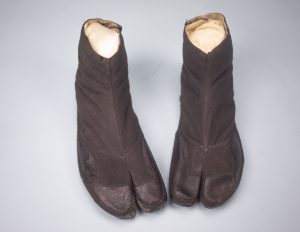
Imperial Japanese Boot:
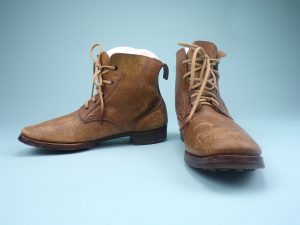
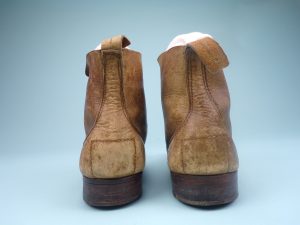
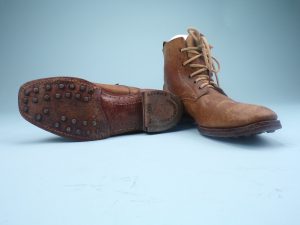
United States War Department illustrations of Japanese uniforms:

Vietnam War Jungle Boots
With Vietnam’s environment consisting of hot, wet, and humid conditions year-round, the U.S. military had to strategically design personnel clothing that tailored to such an environment before sending troops overseas; this was not an easy task. Of the many accessories that the U.S. military adopted for the war, the most important was a U.S. soldier’s combat boots, colloquially known as “Jungle Boots.” These boots were designed to make a soldier feel comfortable within jungle warfare, as the standard leather combat boot became uncomfortable and unwearable for such an environment. The development and use of these boots did not start in Vietnam, however, as soldiers started wearing jungle boots around World War II.
As fighting in the South Pacific intensified by 1942, the U.S. military needed new combat boots to tackle the region’s environment; the newly-designed M-1942 jungle boots were adopted as the best solution to this situation. This particular variation had fused layers of saran with mesh insoles for ventilation, along with corrugated rubber-soles for traction and canvas-uppers to keep insects out. The mindset for this variation was that the ventilating insoles trapped air inside the boot, circulated inside during walking/running, and was exchanged for outside air via the water drain eyelets. After intensive testing in Panama, Venezuela, and other countries, reports on the boots found that the M-1942 variation helped increase the flow of dry outside air to the boots’ mesh insoles and base of the foot; this reduced a soldier’s chance of contracting blisters or other tropical ulcers on their feet. Although the features of this design were useful to some degree, U.S. soldiers began to complain of their little assistance in keeping their feet comfortable, as many argued that they had both “aching arches” from the Vibram soles and chafed legs from the canvas tops.
To remedy this problem, a modified version of the jungle boots was designed and tested, although its production did not occur until the summer of 1945. The newly designed M-1945 tropical combat boots had the same ventilating mesh insole from the M-1942 variation, however it differed with spun nylon, a leather midsole, and full rubber outsole.
By the beginning of the Vietnam War, U.S. soldiers wore M-1945 tropical combat boots surplus as part of their gear, however these boots quickly deteriorated and performed poorly in the thick, dense jungle environment of Vietnam. In response to this dilemma, another variation of the boots was tested in 1962 as cleated black leather and OG107 nylon-webbing tropical combat boot. This style of boots was designed and developed by Wellco, one of the major contractors for the jungle boot project. This variation only lasted until 1965, when the introduction of a newer jungle boot style was adopted by U.S. Armed Forces in Vietnam.
Known as the M-1966 variant, this design was known as the true jungle boot of the war, as it had various new features for feet protection in the environment of Vietnam. In this particular design, the boots’ uppers were cotton, the toe and heel comprising of leather, and improved nylon reinforcements were around the throat of the shoe. A Vibram-type lugged sole was co-joined to the leather heel and toe of the boot. The screened eyelets in the canvas top were intended to drain any wet, moist mud and other substances from the interior of the boot. To keep American soldiers’ feet protected from injuries caused by punji stake traps, these boots included a stainless steel plate in the sole to stop any puncture underneath them. Over the course of the war, the jungle boot received improvements, including mud-clearing outsoles and nylon webbing reinforcements on the uppers. The Vibram third pattern sole jungle boots came out in 1967, with general success in its suitability for the hot, wet, humid environment of Vietnam. U.S. Army contracts for developing this design of combat boots went out to numerous shoe manufactures such as Bata, Genesco, Belleville Shoe MFG Company.
Vietnam Jungle Boots

Discussion Questions
Explain why jungle boots were important to a U.S. soldier in Vietnam. Can you think of any other reasons why they were important?
Why were jungle boots redesigned multiple times over the course of 30 years?
*Pictures of Fashion Archives & Museum’s 1966-67 Jungle Boots are forthcoming.
Photographic examples of Jungle Boots in use by U.S. Army soldiers and Marines during the war:

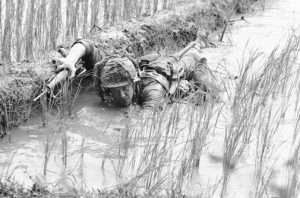
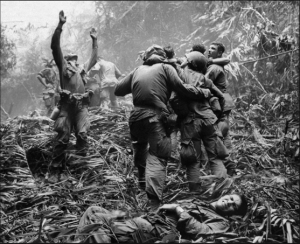
Additional Resources
Tactical Boots Teacher Lesson Plan
Tactical Boots Pre- and Post-Activities
Bibliography
“Army Nurse Corps.” The National Park Service. Accessed April 18, 2024. https://www.nps.gov/articles/armynursecorps.htm.
Barbara H. Hagan School of Nursing: Historical Collection. Military Jungle Boot-1. Molloy University, Rockville Center, New York.
Clapson, Mark. The Blitz Companion: Aerial Warfare, Civilians, and the City Since 1911. London: University of Westminster Press, 2019.
Huet, Henri. “Vietnam’s 35th Anniversary.” The Southern Illinoisan, September 29, 2015. https://thesouthern.com/vietnam-35th-anniversary/image_506486b7-cb56-5837-9bbd-55ffebb39b4e.html.
Hunt, Michael H. A Vietnam War Reader: A Documentary History From American And Vietnamese Perspectives. Chapel Hill: University of North Carolina Press, 2010.
Judge, Sean. “Who Has the Puck?”: Strategic Initiative in Modern, Conventional War. Maxwell Air Force Base, Alabama: Air University Press, 2009.
Kearny, Cresson H. Jungle Snafus…And Remedies. Cave Junction: Oregon Institute of Science and Medicine, 1996.
Munson, Edward Lyman. The Soldier’s Foot and the Military Shoe – A Handbook for Officers and Non Commissioned Officers of the Line. Read Books Limited, 2017.
Pyle, Richard. “Vietnam War Photos That Made a Difference.” The New York Times, September 12, 2013. https://archive.nytimes.com/lens.blogs.nytimes.com/2013/09/12/vietnam-war-photos-that-made-a-difference/.
Tully, John Day, Matthew Masur and Brad Ausitn. Understanding and Teaching the Vietnam War. Madison: The University of Wisconsin Press, 2013.
Unknown Author. “Japanese Jika-Tabi Shoes.” Australian War Memorial. Last updatedDecember 16, 2020. https://www.awm.gov.au/learn/memorial-boxes/4/object-list/japaneseshoes.
Unknown United States Army Signal Corps photographer. Two Japanese soldiers on guard with the barrel of large gun in the foreground. Japan, 1942. Photograph. https://www.loc.gov/item/2002706314/.
Unknown Marine Corps photographer. Surrendering Japanese soldier emerges from cave on island of Saipan. Saipan, 1944. Photograph. https://www.loc.gov/item/94502161/.
Unknown United States Navy photographer. Japanese POW at Guam, with bowed heads after hearing Emperor Hirohito make announcement of Japan’s unconditional surrender.
Wood, C. E. Mud : A Military History. Dulles: Potomac Books Inc., 2006.